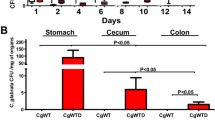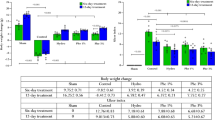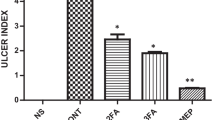Abstract
A low curability of ulcers infected with Candida has been reported in the literature. The aim of the study reported here was to investigate experimentally whether Candida infection affects the healing of ulcers. Candida albicans (the Candida group) or saline (the control group) was administered intragastrically into rats with a cysteamine-induced duodenal ulcer. The duodenal lesions, vascular endothelial growth factor A (VEGF-A) and proliferating cell nuclear antigen (PCNA) were assessed. On Day 7 post-administration, 70.4% rats of the Candida group had a duodenal ulcer compared with 33.3% in the control group (P < 0.05). The duodenal ulcer in the Candida group was significantly larger and deeper than that in the control group. The number of VEGF-A- and PCNA-positive cells was smaller and the area of VEGF-A expression was lower in the Candida group. Using a rat model, we have demonstrated that Candida infection can delay the wound healing process of duodenal ulcers by means of a low expression of VEGF-A and PCNA.






Similar content being viewed by others
References
Higuchi K, Fujiwara Y, Tominaga K, Watanabe T, Shiba M, Nakamura S, Oshitani N, Matsumoto T, Arakawa T (2003) Is eradication sufficient to heal gastric ulcers in patients infected with Helicobacter pylori? A randomized, controlled, prospective study. Aliment Pharmacol Ther 17:111–117
Morishita T, Kamiya T, Munakata Y, Tsuchiya M (1993) Radiologic and endoscopic studies of gastric ulcers associated with Candida infection. Acta Gastroenterol Latinoam 23:223–229
Zwolinska-Wcislo M, Budak A, Bogdal J, Trojanowska D, Stachura J (2001) Fungal colonization of gastric mucosa and its clinical relevance. Med Sci Monit 7:982–988
Wisplinghoff H, Bischoff T, Tallent SM, Seifert H, Wenzel RP, Edmond MB (2004) Nosocomial bloodstream infections in US hospitals: analysis of 24, 179 cases from a prospective nationwide surveillance study. Clin Infect Dis 39:309–317
Nakamura T, Yoshida M, Otani Y, Kameyama K, Ishikawa H, Kumai K, Kubota T, Saikawa Y, Kitajima M (2006) Twelve years’ progress in surgery for perforated gastric and duodenal ulcers: a retrospective study of indications for laparoscopic surgery, post-operative course and the influence of Candida infection. Aliment Pharmacol Ther 24[Suppl 4]:297–302
Nakamura T, Yoshida M, Ishikawa H, Kameyama K, Wakabayashi G, Otani Y, Shimazu M, Tanabe M, Kawachi S, Kumai K, Kubota T, Saikawa Y, Sano K, Kitajima M (2007) Candida albicans aggravates duodenal ulcer perforation induced by administration of cysteamine in rats. J Gastroenterol Hepatol 22:749–756
Brzozowski T, Zwolinska-Wcislo M, Konturek PC, Kwiecien S, Drozdowicz D, Konturek SJ, Stachura J, Budak A, Bogdal J, Pawlik WW, Hahn EG (2005) Influence of gastric colonization with Candida albicans on ulcer healing in rats: effect of ranitidine, aspirin and probiotic therapy. Scand J Gastroenterol 40:286–296
Selye H, Szabo S (1973) Experimental model for production of perforating duodenal ulcers by cysteamine in the rat. Nature 244:458–459
Khomenko T, Szabo S, Deng X, Jadus MR, Ishikawa H, Osapay K, Sandor Z, Chen L (2006) Suppression of early growth response factor-1 with egr-1 antisense oligodeoxynucleotide aggravates experimental duodenal ulcers. Am J Physiol Gastrointest Liver Physiol 290:G1211–1218
Hasebe T, Harasawa S, Miwa T (1998) Factors affecting depth of gastric ulcers. Tokai J Exp Clin Med 23:177–182
Okano H, Onmori R, Tomita N, Ikada Y (2006) Effects of a moderate-intensity static magnetic field on VEGF-A stimulated endothelial capillary tubule formation in vitro. Bioelectromagnetics 27:628–640
Malfertheiner P, Megraud F, O’Morain C, Bazzoli F, El-Omar E, Graham D, Hunt R, Rokkas T, Vakil N, Kuipers EJ (2007) Current concepts in the management of Helicobacter pylori infection—The Maastricht III Consensus Report. Gut 56:772–781
Lam SK, Talley NJ (1998) Report of the 1997 Asia Pacific Consensus Conference on the management of Helicobacter pylori infection. J Gastroenterol Hepatol 13:1–12
Taylor BN, Staib P, Binder A, Biesemeier A, Sehnal M, Rollinghoff M, Morschhauser J, Schroppel K (2005) Profile of Candida albicans-secreted aspartic proteinase elicited during vaginal infection. Infect Immun 73:1828–1835
Calderone RA, Fonzi WA (2001) Virulence factors of Candida albicans. Trends Microbiol 9:327–335
Otani Y, Sakurai Y, Kameyama K, Igarashi N, Yokoyama T, Kubota T, Kumai K, Kitajima M (1997) Matrix metalloproteinase gene expression in chronic gastric ulcer: a potential role of eosinophils in perforation. J Clin Gastroenterol 25[Suppl 1]:S101–104
Claveau I, Mostefaoui Y, Rouabhia M (2004) Basement membrane protein and matrix metalloproteinase deregulation in engineered human oral mucosa following infection with Candida albicans. Matrix Biol 23:477–486
Jones MK, Wang H, Peskar BM, Levin E, Itani RM, Sarfeh IJ, Tarnawski AS (1999) Inhibition of angiogenesis by nonsteroidal anti-inflammatory drugs: insight into mechanisms and implications for cancer growth and ulcer healing. Nat Med 5:1418–1423
Tarnawski A, Stachura J, Krause WJ, Douglass TG, Gergely H (1991) Quality of gastric ulcer healing: a new, emerging concept. J Clin Gastroenterol 13[Suppl 1]:S42–47
Szabo S, Vincze A (2000) Growth factors in ulcer healing: lessons from recent studies. J Physiol Paris 94:77–81
Jones MK, Tomikawa M, Mohajer B, Tarnawski AS (1999) Gastrointestinal mucosal regeneration: role of growth factors. Front Biosci 4:D303–309
Acknowledgments
The encyclopedic duodenal ulcer knowledge of Professor Sandor Szabo (Professor of Pathology and Pharmacology, University of California at Irvine, and Chief of Staff, VA Long Beach Healthcare System, CA, USA) is gratefully acknowledged. The creation of the experimental model in the present study was also directed by Professor Szabo. We also thank Miss. Chika Fukushima for her great assistance in performing this experimental work.
Author information
Authors and Affiliations
Corresponding author
Rights and permissions
About this article
Cite this article
Jin, L., Yoshida, M., Nakamura, T. et al. Candida albicans Infection Delays Duodenal Ulcer Healing in Cysteamine-Induced Duodenal Ulcers in Rats. Dig Dis Sci 53, 2878–2885 (2008). https://doi.org/10.1007/s10620-008-0385-9
Received:
Accepted:
Published:
Issue Date:
DOI: https://doi.org/10.1007/s10620-008-0385-9




